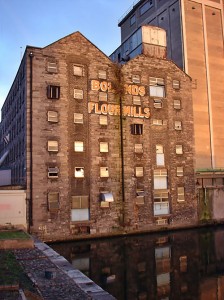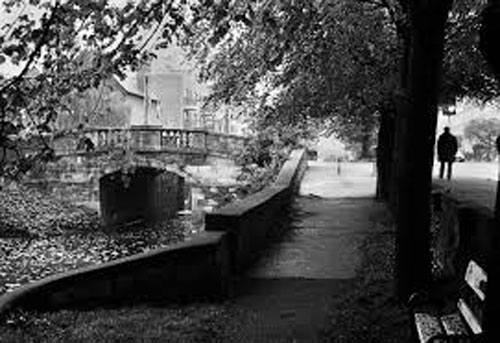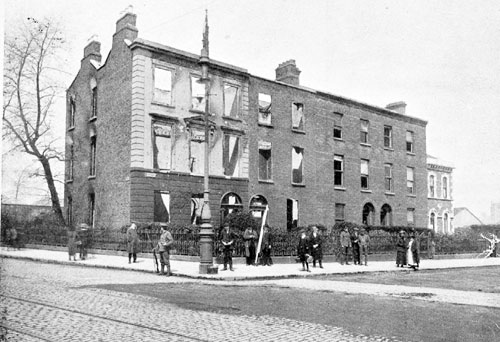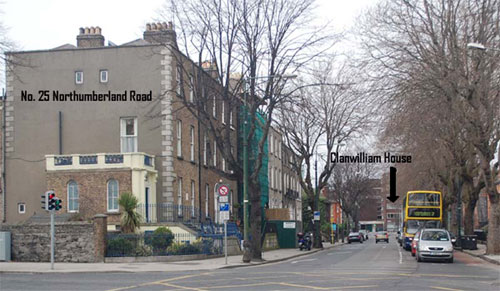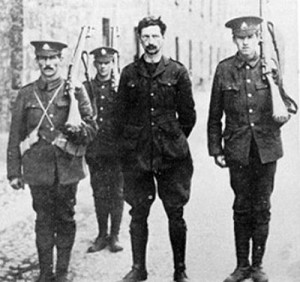Mount St Bridge
Boland’s Mills
The 3rd Battalion under Commandant Eamon de Valera occupied Boland’s bakery around the corner from the flour mills, one mile to the south-east of the GPO, on Grand Canal Dock. The battalion was at a key location as it controlled the railway line and the main road from Dun Laoghaire (then Kingstown) to the city centre.
Aside from the battle at Mount Street Bridge on Wednesday, there were no direct assaults on Boland’s until Thursday. The garrison held out until Sunday when Nurse Elizabeth O’Farrell brought news of the surrender.
The Battle of Mount Street – Easter 1916
On Easter Monday, 24th April 1916, Patrick Pearse read the proclamation of the Irish Republic from the steps of the General Post Office in Sackville Street, Dublin. As this event was unfolding, battalions of Irish Volunteers were occupying strategically located positions throughout Dublin city in order to defend the newly declared republic. Earlier that morning members of the 3rd battalion, Irish Volunteers, under the command of commandant Éamon de Valera, occupied their designated position, at Boland’s Bakery. This was the beginning of one of the most successful military engagements of the 1916 Rising, a triumph for the Irish Volunteers and an unmitigated disaster for the British crown forces.
At 11.00 a.m that morning Lieutenant Michael Malone led a small number of Volunteers from “C” company, 3rd battalion, towards Mount Street Bridge, a key crossing point into Dublin city. Their orders; to prevent British reinforcements from entering Dublin.
Here they set up several well-located positions from the bridge to the junction of Northumberland Road and Pembroke Road. The original plan was to occupy five strategically located positions along this route. The first was Carrisbrooke House, the second was number 25 Northumberland Road, the third and fourth were the Parochial Hall and the Schoolhouse and the fifth and final position was Clanwilliam House. Later, a sixth position, that of Roberts yard would be occupied.
Section Commander George Reynolds, Daniel Byrne, William Ronan and James Doyle occupied Clanwilliam House, a large three storey Georgian building that commanded an excellent view of Mount Street Bridge and Northumberland Road. The Schoolhouse was taken over by Adjutant Denis O’ Donaghue, James Kavanagh, Robert Cooper and James Doyle. Joseph Clarke, Patrick Doyle, James McGrath and William Christian occupied the Parochial Hall. At Number 25 Northumberland Road, Section Commander James Grace, Lieutenant Michael Malone and two young boys Paddy Byrne and Michael Rowe, took up position.
Immediately on entering their designated posts, the Volunteers began turning each position into an impenetrable fortress. Barricades of furniture reinforced the locked doors of each post.
As events were unfolding in Dublin, British High Command in England received an urgent request for reinforcements in order to put down an armed insurrection. The 59th North Midland Division mobilised and began immediate embarkation for Kingstown (Dún Laoghaire), Ireland.
As Lieutenant Malone fortified his post at 25 Northumberland Road, his attention was drawn to the sound of advancing of soldiers coming towards his position. These British soldiers formed part of the Home Guard and were returning from weekend manoeuvres to Beggars Bush Barracks. As they reached the junction of Northumberland Road and Haddington Road, Lieutenant Malone and James Grace opened fire into their ranks. Many men collapsed as they were hit while others ran towards the gates of the nearby barracks for refuge. They were unable to return fire, as their rifles were unloaded. After the gunfire had ceased, bodies littered the street. Locals ran from their houses to assist the wounded British soldiers. The dead and wounded were carried from the roadway.
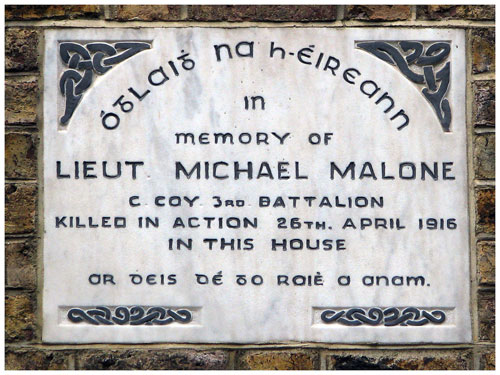 Lieutenant Malone, realising the desperate battle that lay ahead, decided to send home the two young boys that were in number 25 Northumberland Road. At Clanwilliam House, Section Commander George Reynolds made the same decision and sent a young boy home before the fighting intensified. Over the next forty-eight hours the garrison on the road was to change in number. Unknown to Lieutenant Malone, the Schoolhouse was vacated and, its garrison returned to Boland’s Bakery. While some of the Volunteers at Clanwilliam House were directed elsewhere in the vicinity Richard Murphy, Patrick Doyle, Thomas and James Walsh later reinforced the position. The garrison at Clanwilliam House now numbered seven men. In total, seventeen Volunteers had taken up defensive positions on the street.
Lieutenant Malone, realising the desperate battle that lay ahead, decided to send home the two young boys that were in number 25 Northumberland Road. At Clanwilliam House, Section Commander George Reynolds made the same decision and sent a young boy home before the fighting intensified. Over the next forty-eight hours the garrison on the road was to change in number. Unknown to Lieutenant Malone, the Schoolhouse was vacated and, its garrison returned to Boland’s Bakery. While some of the Volunteers at Clanwilliam House were directed elsewhere in the vicinity Richard Murphy, Patrick Doyle, Thomas and James Walsh later reinforced the position. The garrison at Clanwilliam House now numbered seven men. In total, seventeen Volunteers had taken up defensive positions on the street.
Early on Wednesday morning April 26th 1916 the newly arrived British troops assembled on the quayside in Kingstown (Dun Laoghaire). Some of these regiments were made up of young men from Nottingham and Derbyshire, known as the Sherwood Foresters. They were inexperienced soldiers who had only six weeks of basic training. Many had never fired a rifle. Orders were received that the 2/5th and 2/6th battalions were to make their way towards the Royal Hospital Kilmainham via Stillorgan and Donnybrook. The 2/7th and 2/8th battalions were to follow the coast road through Ballsbridge and make their way to Trinity College. Carrying their full military kit they began to march towards the centre of the city. They rested at the Royal Dublin Society in Ballsbridge where they received information that the Schoolhouse on Northumberland Road was occupied by rebel forces. As the battalions moved out Adjutant Captain F.C Dietrichsen met his wife and young children on the roadside. He broke ranks and hugged them. He was delighted to see that they were safe, as he had sent them to Ireland to avoid the increased German Zeppelin raids in England.
From his position at 25 Northumberland Road, Lieutenant Michael Malone could see a section of British troops approaching the junction of Northumberland Road and Haddington Road.
It was twelve noon and James Grace and the young Lieutenant made ready. As the British soldiers reached the junction both men opened fire simultaneously.
The first volley of shots claimed the lives of ten men among them, Captain Dietrichsen. The order to drop was given and the British soldiers lay prone in the middle of the road, in full view of the guns of Malone and Grace who fired in to their ranks. The British troops charged the building but were repulsed, suffering heavy casualties. Attempts to outflank the building also resulted in more casualties. In order to storm the position, the crown forces needed to lay down a covering fire while assaulting the building with hand grenades. The regiments had failed to bring with them an essential part of their armoury, a Lewis machine gun. Having procured some hand grenades the men laid down a covering fire with their rifles and once again charged towards the building. Casualties were again heavy but this time they managed to blow the front door in. At the same time a section of British troops gained entry to the rear of the house via Percy Lane.
Grace opened fire as the British troops entered the hall of Number 25 Northumberland Road. His gun jammed and he shouted to Malone to get out. Grace took refuge in the darkened basement and tried desperately to unblock his weapon. As Malone descended the stairs towards the hall, he was confronted by the British soldiers and was shot dead. In order to clear the house the military threw grenades into the basement but Grace had taken cover behind a metal stove, avoiding serious injury. He remained undetected until after the battle.
The Sherwood Foresters moved towards their next objective, the School house. As they passed the Parochial Hall, the Irish Volunteers fired into their ranks at point blank range. Once again the British troops suffered horrendous casualties as three sections fell, dead or wounded on the roadway. Having expended their supply of ammunition, the Volunteers retreated out the rear of the Hall and were arrested by the military as they attempted to escape.
Having stormed the Schoolhouse and finding it empty, the British soldiers turned their attention to Clanwilliam House. The Volunteers positioned at Clanwilliam House opened fire into the British troops as they advanced up Northumberland Road towards the bridge at Mount Street. A desperate battle ensued. The defenders of Clanwilliam House fired volley after volley into the charging British troops. Time and time again they failed to cross the bridge. Bodies littered the road; the moans and cries of the wounded filled the air. Nurses and doctors from the nearby Sir Patrick Dun’s hospital came forward on to the bridge and after obtaining a brief ceasefire the wounded were taken from the battlefield. Moments later the battle resumed with the same vigour. On the sound of a whistle the British soldiers charged the Volunteer’s position. After many desperate attempts to cross the bridge the British finally succeeded and reached Clanwilliam House. Unable to gain entry via the doorway, they broke a window and climbed through. The military began clearing the building by throwing grenades into each room, an action that caused the building to catch fire and burn to the ground. In the desperate action at Clanwilliam House, three Volunteers lost their lives as crown forces assaulted their position. The surviving four Volunteers escaped through the rear of the building and evaded capture. Official British casualties amounted to four officers and 216 other ranks killed or wounded during the engagement at Mount Street.
Throughout the battle the Volunteer positions were supported by sniper fire from Boland’s Bakery and the nearby railway tracks. Their actions kept the small British garrison in the adjacent Beggars Bush Barracks pinned down for the duration of the Rising. Sniper fire from each side resulted in many civilian casualties. Mrs Elizabeth Kane was shot dead and her daughter seriously wounded, as was Mr. Hayter, a local grocer. Mr C. Hyland who assisted the wounded Sherwood Foresters on the bridge was shot dead as he stood in the doorway of his house. A British officer, Captain Gerrard, stationed in the nearby barracks recalls,
One of the sentries in Beggars Bush Barracks, about Tuesday evening, said to me, ‘I beg your pardon, sir, I have just shot two girls.’ I said, ‘what on earth did you do that for?’ He said, ‘I thought they were rebels. I was told they were dressed in all classes of attire.’ At a range of about two hundred yards I saw two girls-about twenty (years old) – lying dead.
The story of the Battle of Mount Street Bridge is both tragic and heroic. The scenes that unfolded in this leafy suburb were reminiscent of the terrible warfare of the Western Front during the First World War. It is a little known fact that there were more civilian casualties in the 1916 Rising than there were military casualties.
Today, much of central Dublin has changed as many areas were rebuilt in the years that followed the Rising. Though Clanwilliam House was destroyed, the other posts on Northumberland Road remain more or less as they were that Easter week, a stark reminder of the carnage and death visited on this stretch of road that spring day of 1916.
Gerrard, Capt. E W.S Bureau of Military History
(By kind permission of Author Paul O’Brien. “Blood on the Streets”, Mercier Press, 2008. A part of the 1916 in focus collection)

